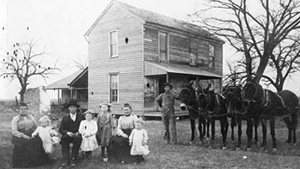
Over the years, Joppa/Joppee has been spelled numerous ways including Joppa, Joppee, Joppie and Joppy. This article is intended to be an overview of the history of the community. We will use the name Joppee for convenience, since this is how the name has usually been pronounced. Joppee is one of the older Freedman communities in Dallas County dating back to the 1860s and 1870s. The community was settled by freed slaves, at least some of whom may have come from the nearby Miller plantation and it still exists today.

The name Joppa/Joppee was likely taken from the Bible. The biblical town of Joppa is believed to be one of the oldest cities in the world. It is referred to numerous times in both the Old and New Testaments. In Israel, Joppa still exists today and is known as Jaffa. It is located roughly 30 and 40 miles northwest of Jerusalem on the Mediterranean Sea. Joppa served as the main seaport for Jerusalem. In Hebrew, the word means “beautiful.” Some of the Bible stories in which it is mentioned include Joppa being the source of timber for King Solomon’s temple, in the Old Testament story of Jonah and various stories in the New Testament.
In Dallas County, Joppee is located near the intersection of I-45 and Loop 12 in the southeastern part of Dallas County. After the Indigenous or Native American inhabitants, some of the early inhabitants were Robinson F. Smith and Lorenzo Van Cleave who received land grants for their service on behalf of the Republic of Texas. The land continued to change hands until it came into the possession of a plantation owner named Miller who was a slave owner.
One of the slaves was Henry Critz Hines. At the moment, not a great deal of personal information is known about Mr. Hines, other than he was once a slave on the Miller Plantation and may have previously been a slave in Missouri or Alabama. Perhaps readers will help to contribute to his story. Upon emancipation, Mr. Hines remained in the area, settling in Dallas County along with a number of other former slaves of the Miller place and nearby plantations as early as the 1860s. They were also believed to have been joined by freedmen from East Texas and other locations.
The Houston and Texas Central Railroad is said to have arrived in Dallas in 1872, reaching the Joppee area where it crossed the Trinity River several years later. At that point, the Trinity flowed south in a generally southeasterly direction. The rail line continued on the north side of the Trinity from that point on, turning roughly north near downtown Dallas. Mr. Hines was either sold or given a ferry by Miller and Hines operated it for a number of years until it began to become obsolete. The ferry was damaged by a storm and flood and ceased operations around 1890.
The community was informally bounded by the Trinity to the north and the rail line to the south. In the late 1880s, the Zion Missionary Baptist Church moved to the area from another location closer to downtown. A second church, the Gethsemane Missionary Baptist Church, came some years later. Joppee had its own school system for about forty years until Dallas County schools were desegregated. At some point, the Zion Missionary Baptist Church building was used for the school building. Joppee was annexed into the City of Dallas in 1955 but its schools continued to be part of the Wilmer Hutchins ISD until desegregation. Joppee is assisted by the South Central Civic League, chartered by Joppee resident Laurabelle Foster in 1948. Over 100 years after rail lines reached the area, a concrete and steel structure called the Freedman’s Town Memorial Bridge was dedicated in June, 2007. It is an overpass constructed where Linfield Road intersects with the railroad tracks and allows traffic to progress over the rail lines.
We will continue to add to this account as more information becomes available.

Sources: southcentralcivicleague.org, bcworkshop.org/joppa-neighborhood-stories, Dallas Morning News


